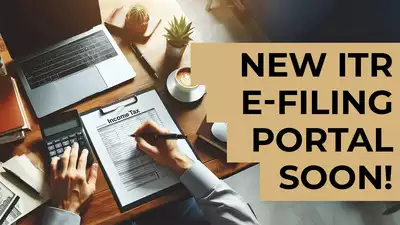

new ITR e-filing portal soon? The Income Tax Department is set to revamp the e-filing ITR portal with substantial changes aimed at making it more user-friendly for taxpayers.
An ET report quotes an internal circular from the tax department dated October 8, 2024, which is not publicly available, “The operations phase of the existing Integrated e-filing and Centralized Processing Center (IEC) 2.0 is coming to an end and the process of bringing in a new project, Project IEC 3.0 (that shall replace the existing Project IEC 2.0) has already been initiated.”
The upcoming Project IEC 3.0 is expected to offer not only a continuation of the services provided by Project IEC 2.0 but also to implement a significantly improved system that ensures a secure and user-friendly environment for taxpayers.The tax department’s internal circular emphasizes the commitment to enhancing the e-filing experience and streamlining the process for taxpayers.
The IEC project aims to provide an e-filing platform that enables taxpayers to file their ITRs electronically, submit statutory forms, and access various other services.
Also Read | New UPI transaction limits announced! Check new per transaction limits for UPI Lite Wallet & UPI 123Pay
The Centralized Processing Center (cpc) is a crucial component of the IEC project, responsible for processing the submitted ITRs through the e-filing portal and ITBA. The tax department’s internal circular also mentioned, “In addition to the above, the IEC provides a Back-Office (BO) portal, which is used by the field officers to access taxpayer filing and processing data.”
The income tax department has emphasized the significance of Project IEC 3.0 in an internal circular, noting its potential to greatly influence the department’s operations, taxpayers, and the general public in the coming years. To ensure that the project is user-friendly for taxpayers, the department believes it is crucial to gather feedback and suggestions from ITR portal users and other stakeholders.
“It is considered desirable to hold wide consultations with the various Project IEC users/ stakeholders and obtain their opinion/views/suggestions in respect of the good features/deficiencies of the existing Project IEC 2.0 as well as the tangible improvements that may be made in IEC 3.0,” said the tax department in the internal circular.
According to the income tax department, a committee chaired by an officer of at least CIT rank should be formed within a week of the order issued on October 8, 2024. The committee will be tasked with collecting opinions, views, and suggestions from department officers. , tax professionals, taxpayers, and other stakeholders in their respective regions. The department has directed that the committee’s findings should be submitted via email by November 30, 2024.
Also Read | PPF Calculator: How to become a crorepati with Public Provident Fund? explained
Ashish Niraj, a Chartered Accountant and Partner at ASN & Company, a CA firm, believes that the shift from IEC 2.0 to IEC 3.0 has the potential to provide a more user-friendly experience for all parties involved.
The Income Tax Department is set to launch Project IEC 3.0, which promises to bring about significant improvements in the processing of ITRs. The new system is expected to leverage cutting-edge information technology to expedite the processing of ITRs, potentially leading to faster refunds for taxpayers.
Additionally, the implementation of IEC 3.0 is anticipated to greatly reduce taxpayer grievances, as it aims to address the issues faced by taxpayers and professionals in the previous version, IEC 2.0.
“Project IEC 3.0 aims to induce high speed information technology which will enable faster processing of ITRs and thereby taxpayers may be able to get quicker refunds if any. It is also expected that with the introduction of latest technology in IEC 3.0 taxpayers grievances may greatly reduce Moreover, I feel stringent data quality checks should be implemented in IEC 2.0 sometimes taxpayers and professionals faced problems in downloading last year filed ITR Forms, downloading 26AS, challan payment failed issues, etc. in IEC 3.0,” says Niraj.
However, the success of the new system will depend on its ability to handle the growing number of taxpayers and their needs.







